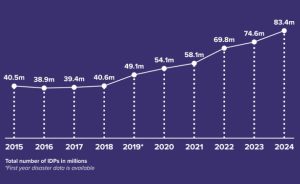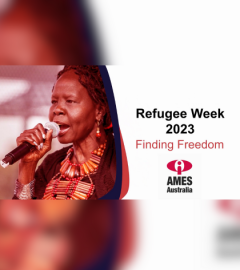Lives of displaced people worsening – report finds
The wellbeing of internally displacement people across the world is worsening because of lower levels of access to nutrition, education and health care, a new report says.
The ‘2025 Global Report on Internal Displacement’, compiled by the IOM’s Internal Displacement Monitoring Centre (IDMC) has analysed the characteristics of communities in areas affected by internal displacement.
It found that 88 per cent of these communities have a higher proportion of children than the global average, 93 per cent have lower income, 66 per cent have lower levels of education, and 61 per cent have lower life expectancy, highlighting their disproportionate vulnerability.
The report’s data also shows that these vulnerabilities have grown more severe in recent years.
In 2018, internal displacements occurred in areas where 28 per cent of the population were children, rising to 40 per cent in 2024. The average annual income of populations in impacted areas fell dramatically, from USD 11,800 in 2018 to USD 1,600 in 2024.
The study also highlights stark differences between communities affected by different displacement causes. For example, populations impacted by drought displacement, most common in Ethiopia and Somalia, are young (18 years on average), include a high proportion of children (43 per cent), and have limited education (three years of schooling), low life expectancy (61 years), and low annual income ($US2,400).
Differences are also evident in livelihoods and land use. The study finds that storm and flood displacements most heavily impact farming populations, while drought displacements hit pastoral communities hardest. Conflict and wildfire displacements are most concentrated in urban and semi-urban areas.
The analysis combined geolocated data covering 349 million internal displacements, or forced movements of people, worldwide between 2018 and 2024 with high-resolution global maps of demographic, socio-economic, and land-use variables.
“The rise in conflict in recent years in countries and territories such as the Democratic Republic of Congo, Lebanon, Palestine, Sudan and Ukraine led to an increase in the number of IDPs,” the report said.
“They added to the tens of millions living in protracted displacement in countries such as Afghanistan, Colombia, Syria and Yemen. The impacts of disasters on housing and livelihoods also meant that many people could not find durable solutions and were still displaced at the end of the year,” the report said.
“Humanitarian aid alone will not suffice to reduce the scale of displacement. To help IDPs put a sustainable end to their situation, governments need to set up policies and take actions that resolve conflicts and build peace, reduce poverty and disaster risk, and enable people to return, resettle, or locally integrate in host communities,” it concluded.
The report comes at a time when global humanitarian funding has been decimated, making the efficient allocation of resources more important than ever.
IOM Deputy Director for Operations Ugochi Daniels said displacement was having an increasingly negative impact of communities.
“This report shows, for the first time, internal displacement worldwide not just as dots on a map, but as human lives shaped by age, education, health, and livelihood. It’s about far more than losing a home,” Ms Daniels said.
“It reminds us that upholding the rights and dignity of displaced people requires urgent action to ensure all their needs are met.”
IDMC Director Alexandra Bilak said internal displacement disrupts people’s lives, from their education to their livelihood.
“Investing in reliable data gives governments and partners the evidence to identify who is most at risk and direct resources where they are needed most. But data alone is not enough – it must be matched by sustained government action to turn evidence into solutions,” she said.
Read the full report: https://www.internal-displacement.org/global-report/grid2025/












